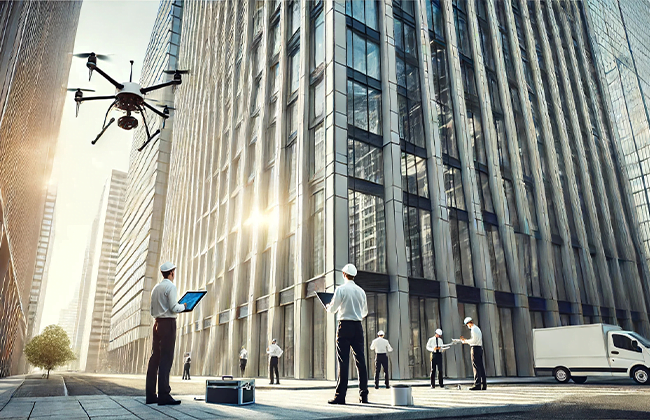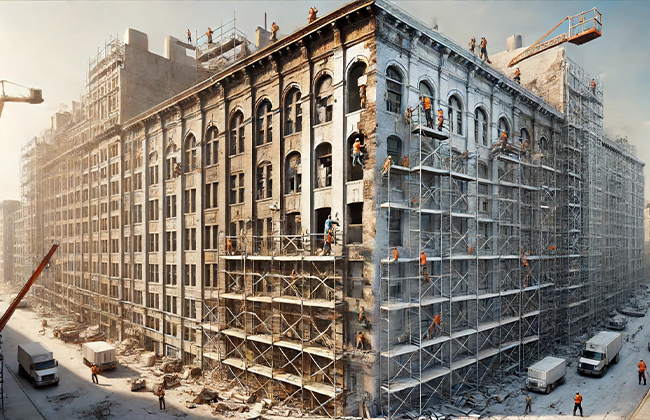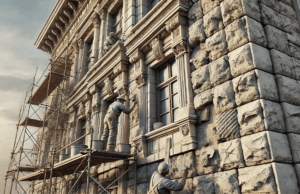Building facade repair is crucial for maintaining the structural integrity and aesthetic appeal of any building. This process involves assessing and rectifying damage to the external surfaces, ensuring that the building not only looks appealing but is also structurally sound. Whether dealing with weathering, environmental impacts, or just age-related wear and tear, building facade repair is essential for the long-term upkeep of your property.
What is Building Facade Repair?
Building facade repair is a critical maintenance task that focuses on restoring the external surfaces of buildings to their original state or better. This process is vital not just for improving a building’s appearance, but also for reinforcing structural elements to safeguard against potential hazards. Whether dealing with aging materials, environmental damage, or just regular wear and tear, understanding the proper techniques and approaches to facade repair can significantly extend the lifespan of a building and enhance its safety and aesthetic appeal.
Common Signs of Facade Deterioration
When it comes to maintaining the longevity and safety of a building, recognizing the early signs of facade deterioration is crucial. Here’s a closer look at some of the most common indicators that your building’s facade might need attention:
1. Cracking and Spalling of Concrete:
Cracking in concrete facades can range from hairline to significant cracks. These cracks often emerge from structural settling or thermal expansion and contraction. Spalling, where chunks of concrete break away, typically occurs due to water ingress, which causes the internal steel reinforcements to rust and expand, pushing against the concrete. Regularly checking for these signs and addressing them quickly can prevent minor issues from becoming major structural problems.
2. Discoloration and Staining:
Discoloration and staining often appear as irregular patches of color on the facade, which not only detracts from the building’s appearance but can also signify deeper issues. Causes include water damage, rust, and the growth of mold or algae, often exacerbated by poor drainage or flashing issues. By cleaning and repairing the sources of moisture, you can enhance the facade’s appearance and prevent further damage.
3. Loose or Bulging Bricks:
If you notice bricks that seem to protrude or move when touched, this is a clear warning sign. Loose or bulging bricks may result from foundation issues, incorrect mortar application, or long-term water damage. This condition not only risks the bricks falling but also compromises the building’s thermal insulation. Securing these bricks as soon as possible can avert more extensive repairs down the line.
4. Deterioration of Mortar Joints:
The mortar joints between bricks play a crucial role in maintaining the structural integrity of masonry facades. Over time, these joints can deteriorate due to weather exposure or moisture, leading to gaps where water can enter and cause further damage. Repointing, the process of renewing the mortar joints, can significantly restore the facade’s stability and waterproofing qualities.
Identifying these signs early is not just about fixing what’s broken; it’s about proactive maintenance that can lead to more timely and cost-effective repairs. Regular inspections and addressing these common issues promptly can help maintain the structural integrity and aesthetic value of your building, ensuring it stands strong and looks great for years to come.
Repair Techniques for Building Facades
Maintaining and repairing building facades is essential to preserve their structural integrity and aesthetic value. Here, we dive into some effective repair techniques that address various issues commonly found in building facades:
a. Tuckpointing:
Tuckpointing is a precise technique that revitalizes the appearance and stability of masonry buildings. This process involves removing old, deteriorated mortar from between bricks and replacing it with new mortar. Not only does this enhance the visual appeal of the facade, but it also strengthens the masonry against weather elements and prevents water infiltration. When done correctly, tuckpointing restores the facade’s original condition, extending its lifespan significantly.
b. Sealant Replacement:
Sealants play a crucial role in waterproofing building facades, sealing joints and gaps where materials meet, such as around windows and door frames. Over time, these sealants can degrade due to exposure to weather and UV light, losing their effectiveness. Replacing old sealants with new, high-quality products prevents water penetration, protects the underlying materials, and maintains the energy efficiency of the building. Regular checks and timely replacement of sealants are vital maintenance tasks that keep water damage at bay.
c. Concrete Repairs:
Concrete facades may develop various defects, such as cracks, spalling, and chipping, mainly due to environmental factors and aging. Repair techniques can range from simple patching, where small areas of damage are filled and smoothed over, to complete replacement of large sections of concrete. Effective repairs require a thorough evaluation of the damage to choose the right method and materials, ensuring that the repair blends seamlessly with the original structure and provides lasting results.
d. Cleaning and Maintenance:
Regular cleaning is crucial for maintaining the aesthetic and structural integrity of building facades. Dirt, grime, and biological growth like mold and algae not only detract from the building’s appearance but can also cause physical damage over time. Cleaning techniques such as power washing, chemical cleaning, or gentle hand washing, depending on the facade material, can significantly improve the look of the building. Additionally, routine maintenance checks allow for the early detection of potential issues, enabling timely repairs that prevent minor problems from escalating.
By implementing these repair techniques, building managers and owners can ensure that their facades remain in excellent condition, enhancing both the property’s curb appeal and its long-term durability. Regular, proactive maintenance is key to avoiding costly repairs and extending the life of the building’s facade.
The Role of a Building Facade Survey

Conducting a building facade survey is a crucial step in maintaining and restoring the structural integrity and aesthetic of any building. This detailed evaluation, carried out by skilled professionals, is designed to identify any existing issues with the facade that may require repairs or improvements.
What Does a Facade Survey Involve?
A facade survey typically involves a thorough inspection of the building’s exterior, using a variety of techniques. Inspectors may use visual assessments from the ground or via elevated platforms, photographic documentation, and sometimes more advanced techniques like drone surveillance or 3D scanning. The goal is to get a comprehensive view of the facade’s condition, noting problems like cracks, erosion, loose elements, and water damage.
Why is a Facade Survey Important?
1. Early Detection of Problems:
By identifying potential issues early on, a facade survey can save building owners significant amounts of money in the long run. Early repairs can prevent minor issues from becoming major structural problems that are more complex and costly to fix.
2. Safety:
Regular facade surveys help ensure the safety of both the building occupants and the general public. Facades in disrepair can pose serious risks, including falling debris. A survey can identify these risks before they lead to accidents.
3. Regulatory Compliance:
In many areas, local building codes require regular facade inspections to ensure public safety. These regulations often mandate repairs and maintenance to keep buildings up to standard and safe for everyone.
4. Preservation of Property Value:
A well-maintained facade enhances the visual appeal and structural integrity of a building, which in turn preserves or increases its property value. Regular surveys and subsequent repairs play a key role in this process.
5. Strategic Planning:
Facade surveys provide essential information that helps in planning future maintenance and budgeting. Knowing the current state of the facade allows building managers to effectively allocate resources for necessary repairs and maintenance.
Choosing the Right Contractor for Facade Repair
Selecting the right contractor for facade repair is crucial to ensuring the job is done effectively and efficiently. A competent contractor not only addresses current issues but also helps prevent future problems, thereby extending the lifespan of your building’s facade. Here’s how to make sure you pick the best professional for the job.
1. Experience and Specialization:
Look for a contractor with extensive experience in facade repair, particularly with buildings similar to yours. Specialization matters because different building materials and architectural styles require specific repair techniques. A contractor familiar with your type of building will likely provide higher quality workmanship and better outcomes.
2. Licensing and Certification:
Ensure that the contractor you choose is licensed to perform construction and repair work in your area. Proper licensing indicates that the contractor adheres to industry standards and local building codes. Additionally, certifications in specific repair techniques or materials can be a significant plus, showing that the contractor has received training and recognizes best practices in facade repair.
3. Reputation and References:
Check the contractor’s reputation by reading reviews and testimonials from past clients. Don’t hesitate to ask for references and follow up with them to inquire about their experience with the contractor. Were they satisfied with the work done? Was the contractor professional and easy to communicate with? Answers to these questions can provide invaluable insights into the contractor’s reliability and quality of service.
4. Detailed Project Outlines and Estimates:
A reliable contractor should provide a detailed project outline that includes the scope of work, materials to be used, timelines, and cost estimates. This transparency helps you understand exactly what the contractor plans to do and how much it will cost, preventing surprises down the line. Compare estimates from several contractors to ensure you’re getting competitive pricing and reasonable terms.
5. Warranty and After-Sales Service:
Choose a contractor who offers a warranty on their work. A warranty indicates that the contractor stands behind the quality of their work and is willing to address any issues that may arise after the project is completed. Additionally, good after-sales service—such as follow-up inspections or maintenance tips—is a sign of a contractor who cares about the longevity of their work and client satisfaction.
6. Communication and Professionalism:
Throughout the selection process, pay attention to the contractor’s communication style. Are they prompt in responding to your inquiries? Do they explain technical terms clearly? A contractor who communicates effectively and treats you with professionalism is more likely to be a reliable partner in maintaining your building’s facade.
By considering these factors, you can select a facade repair contractor who not only meets your project’s needs but also ensures a hassle-free and successful repair process. Remember, the right contractor is a key component in preserving the structural integrity and aesthetic value of your building, making this choice an important investment in your property’s future.
Legal and Safety Considerations in Facade Repair
When planning facade repairs, it’s not just about aesthetics and structural integrity; legal and safety considerations play a critical role in ensuring that the work is up to code and protects both workers and the public. Here’s what you need to know to navigate these aspects effectively.
1. Understanding Local Building Codes:
Local building codes are designed to ensure safety and compliance in construction practices. These regulations often include specific requirements for facade inspections, especially for older and high-rise buildings. It’s crucial to familiarize yourself with these codes to ensure your facade repair project complies with local standards, which can vary significantly from one jurisdiction to another.
2. Regular Inspections and Compliance:
Many localities require regular facade inspections to identify potential safety hazards like loose bricks or deteriorating supports. These inspections must be conducted by qualified professionals who can accurately assess the facade’s condition and recommend necessary repairs. Compliance with these inspections is not just a legal requirement but a critical safety measure that can prevent accidents and liabilities.
3. Permit Requirements:
Before commencing any facade repair work, check if you need a permit. Most structural repairs, especially on the building’s exterior, require permits to ensure that the work is reviewed and approved by local authorities. This process helps ensure that the repairs meet safety standards and are conducted properly.
4. Safety Measures During Repairs:
Safety is paramount, not just for the workers on the scaffoldings but also for pedestrians and residents around the repair site. Proper safety measures include installing robust scaffolding, using safety nets to catch falling debris, and implementing traffic controls if necessary. Ensuring that these measures are in place can prevent accidents and protect the public.
5. Contractor’s Insurance and Liability:
Ensure that the contractor you hire carries the appropriate insurance, including liability and workers’ compensation insurance. This protects you in case of accidents or damage to property during the repair process. It also ensures that in the event of an injury, the contractor’s insurance will cover medical costs, thus safeguarding you from potential legal and financial liabilities.
6. Documentation and Reporting:
Maintaining thorough documentation of all inspections, repairs, and compliance measures is crucial. This documentation should include detailed reports from inspections, copies of permits, repair details, and any communications with local authorities. These records can be invaluable in the event of disputes or if regulatory bodies request proof of compliance.
By taking these legal and safety considerations into account, you ensure that your facade repair project not only enhances the building’s longevity and aesthetics but also adheres to legal standards and protects the safety of everyone involved. Always stay informed and proactive about these aspects to manage a successful and compliant facade repair project.
Future-Proofing Your Building Facade
Future-proofing your building facade is about preparing it to withstand future challenges, whether they be environmental, structural, or technological. Investing in durable materials and innovative technologies not only extends the life of your facade but also enhances its functionality and appearance. Here’s how you can effectively future-proof your building facade:
1. Choosing Durable Materials:
Selecting the right materials is crucial for a facade that lasts. Materials like high-quality brick, stone, and certain types of weather-resistant metals, such as copper or zinc, offer longevity and require minimal maintenance. These materials withstand harsh weather conditions and environmental stressors better than their less durable counterparts.
2. Implementing Advanced Technologies:
Advancements in building technologies offer new opportunities to enhance facade durability and efficiency:
- Self-healing Concrete: This cutting-edge material contains bacteria that produce limestone when activated by water, effectively “healing” cracks that form in the concrete. This technology significantly extends the lifespan of concrete facades by reducing the need for frequent repairs.
- Water-repellent Coatings: Applying water-repellent coatings can protect your facade from moisture-induced damage such as mold, mildew, and erosion. These coatings create a barrier that repels water while allowing the facade to breathe, preventing moisture accumulation.
3. Energy-Efficient Solutions:
Incorporating energy-efficient solutions like thermal insulation and reflective coatings can greatly enhance the environmental performance of your building. These technologies not only contribute to facade preservation by regulating temperature fluctuations but also reduce energy costs.
4. Regular Maintenance Plans:
Future-proofing is also about proactive maintenance. Setting up a regular maintenance schedule ensures that potential issues are identified and addressed before they become major problems. Regular cleaning, inspections, and minor repairs play a significant role in maintaining the structural integrity and aesthetic value of the facade over time.
5. Adapting to Climate Change:
With changing climate conditions, it’s important to consider how environmental factors such as increased precipitation, higher temperatures, and potential seismic activity could impact your facade. Upgrading drainage systems to handle more intense rain events and choosing materials that can withstand higher temperatures and UV exposure are practical steps toward making your facade more resilient.
By integrating these strategies, you can not only extend the lifespan of your building’s facade but also enhance its performance and appearance. Future-proofing is an investment in the longevity and sustainability of your property, ensuring it remains safe, functional, and visually appealing for years to come.
Conclusion:
If you’ve found this guide on building facade repair helpful and are looking for a professional contractor to address your building facade repair needs, don’t hesitate to reach out. Ensuring your building’s facade is properly maintained is key to preserving its value and safety. For expert service in building facade repair, contact us today at (+1) 917-355-8556.
FAQs:
Q: What is the importance of timely building facade repair?
A: Timely building facade repair prevents minor damages from escalating into costly repairs, ensuring the building remains safe and visually attractive.
Q: How often should building facade repair be conducted?
A: Building facade repair should be performed regularly, depending on the building’s exposure to environmental conditions and the materials used in its construction.
Q: What are common problems addressed by building facade repair?
A: Common issues that building facade repair addresses include cracks, spalling, and water damage. These and general wear can compromise a building’s structural integrity.
Q: Can building facade repair improve energy efficiency?
A: Yes, building facade repair can significantly enhance a building’s energy efficiency. It seals leaks and improves insulation, thereby reducing heating and cooling costs.
Q: What should be considered when choosing a contractor for building facade repair?
A: When choosing a contractor for building facade repair, consider their experience and reputation. Also assess their ability to provide a comprehensive assessment. They should offer a clear plan for the necessary repairs.






